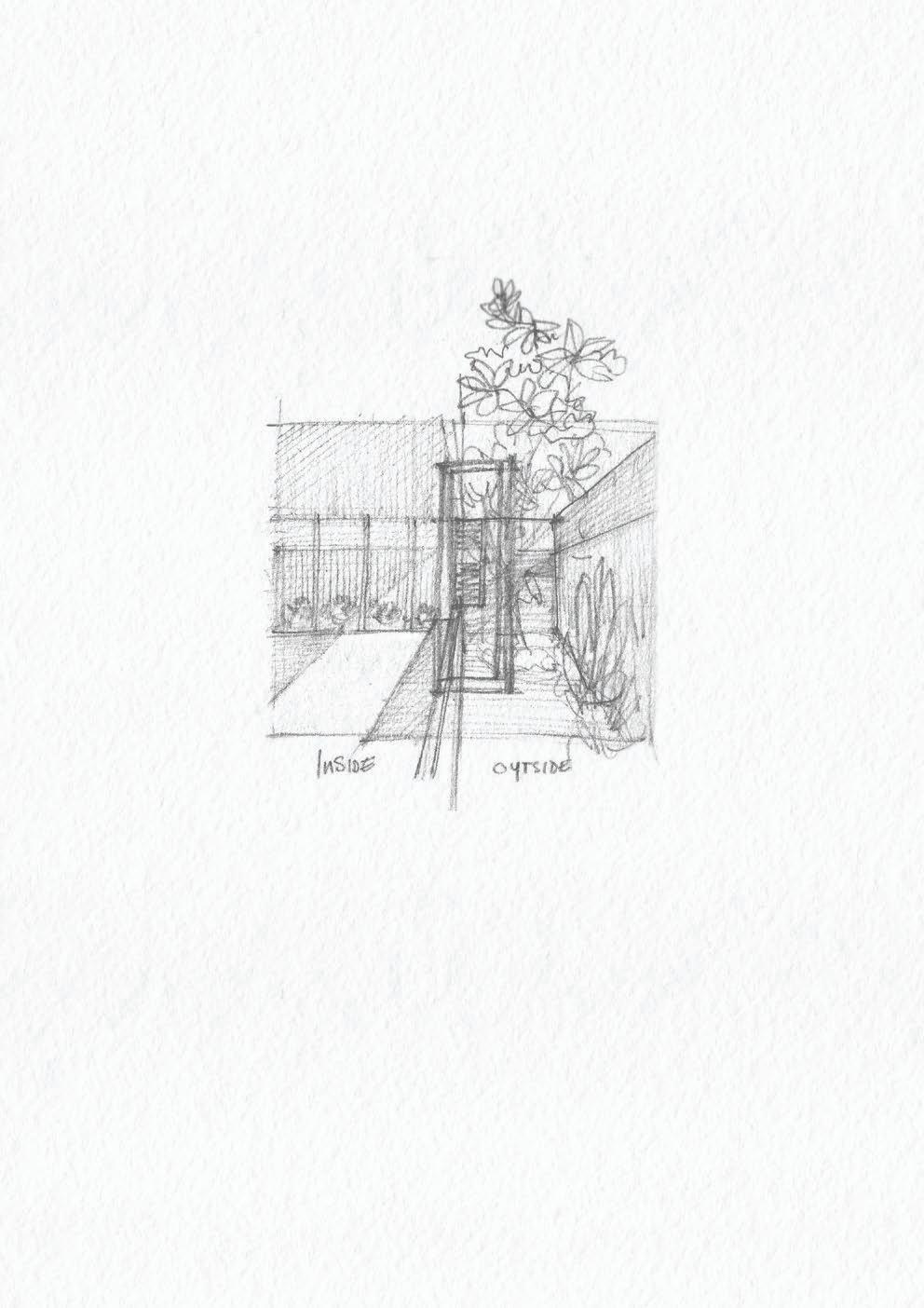
DESIGN PORTFOLIO I SELECTED WORKS S H U V R A D A S
PERSONAL DETAIL

Born Nationality
Written Language
Spoken Language
EDUCATION
2010 - 2016
27 January 1993
Bangladeshi
Bangla, English
Bangla, English
RECOGNITION / COMMENDATIONS
2023 Project Exhibition : HYDROPOD PLAYSCAPE
UIA World Congress of Architects 2023 in Copenhagen, Denmark
(Community Architecture and Human Rights pavilion )
2022 Commendation : HYDROPOD PLAYSCAPE Berger Award for Excellence in Architecture in association with IAB,
Bangladesh University of Engineering & Technology (BUET)
Bachelor of Architecture (B.Arch)




WORKSHOP
2017 Summer School
Laurie Baker Centre for Habitat Studies at Thiruvananthapuram, India
(Participation in Architectural Exhibition )
2020 4th BEST PAPER PRIZE
3rd International Conference on Smart Villages and Rural Development (COSVARD 2020)
(Organized by the Smart Villages Lab at the University of Melbourne and Assam Engineering College)
2019 Gold Mention
SKILLS
DRAWING
Freehand Sktches
Watercolor
Pastel and charcoal
COMPUTER
Autodesk AutoCAD
Adobe Illustrator
Adobe Photoshop
SketchUp
Rhinoceros 3D
Grasshopper
Autodesk 3ds Max

Lumion
“Accentuating Rain”
Architectural Design Competition
(Organized by Arch Twist)
2019 Honorary Mention
“Tropical House for ORANG ASLI” International Design Competition
(Organized by PAM, KLAF 2019)
2016 Epilogue '09 : Ideas : Expo : Projects Published Book of Compiled Thesis Projects
(Participation in Architectural Exhibition of Thesis Projects)
2015 Designing Resilience in Asia 2015
International Student Idea Competition
Selected as a team for the Jury in Singapore from BUET , Top 20 nalists
Shuvra Das
Architectural Designer
Contact shuvra.das.arch@gmail.com +88 01710470792
TABLE OF CONTENT LIVING ON A GRAVE YARD : RETHINKING AN INDUSTRIAL LANDSCAPE FOR SHIP RECYCLING Undergrade Thesis, 2016 04-09 HOUSING IN MAJHIPARA : VISIONING SUSTAINABLE VILLAGE Studio Project , 2015 10-13 ACADEMIC PROJECT HYDROPOD PLAYSCAPE: AN INTEGRATED WATER HARVESTING AND PLAYSCAPE FACILITIES Construction Completed in 2020 16-21 UPAZILA COMMUNITY PARK: RECLAIMING AN ABUNDANT LAND THROUGH PLACEMAKING Construction Completed in 2022 22-25 PROFESSIONAL PROJECT REMINISCENCE : THE TROPICAL SHED KLAF - Tropical House For Orang Asli Design Competition, 2019 14-15 COMPETITION PROJECT P 03
LIVING ON A GRAVE YARD : RETHINKING AN INDUSTRIAL LANDSCAPE FOR SHIP RECYCLING
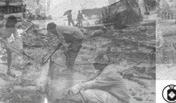
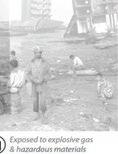
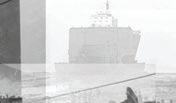


INSTRUCTOR : Dr. Khandaker Shabbir Ahmed , Tasneem Tariq, Maherul Kader Prince Thesis Project. Design duration : Fourteen weeks
June 2016
The Bangladeshi shipbreaking yards are close to Chattogram, a signi cant port city formerly known as Chittagong. They cover around 15 kilometers of the Sitakund region's shoreline. Incentives behind the development of the shipbreaking industry are multi-faceted, among which economic bene ts and employment opportunities are most prominent. However, the industry received much attention globally due to many fatal accidents causing loss of life and environmental degradation due to unsafe working practices, especially in South Asia.
The framework of Action outlines the Project, both policies and infrastructure, for envisioning a prospectful future of this industry in Bangladesh. The main focus of the Project:
- Studying the work ow of the industry and the circulation of raw materials



- Exploring the scope of intervention to improve the working conditions and control the level of pollution
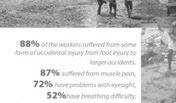
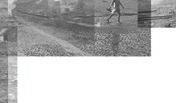
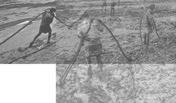
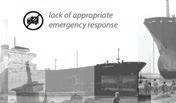
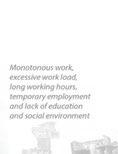

- Ship is dismantled after bringing it between two tracks, facilitating automation for the safety of the workers
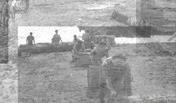
- Designing an Apparatus for accommodating mechanical equipment and ensuring safe physical access and urgent needs of the workers working in the intertidal zone


- Generated waste during the dismantling can be pumped out and sent to the storage by the ducting system.
- Addressing the social needs of the workers in the master plan and directing the circulation of the raw materials to make the adjacent village less interrupted.
- Creating a public interface between the industry and the village to ensure public surveillance.



P 04
A Constructed Panaroma from collected images of the local Ship Breaking Yards
Existing Ship Breaking Process: BEACHING METHOD


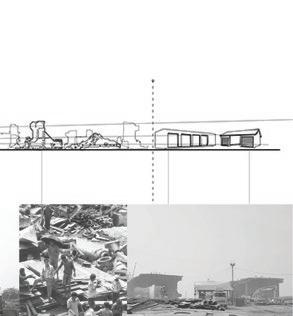
Intertidal zone
The vessel is grounded deliberately on the soft mud ats of the intertidal zone during high tide and breaking operations usually take place during low tide.
Primary Breaking zone

Towing large Ship segment by pulling it by Winch machine from Mud zone to Dry zone
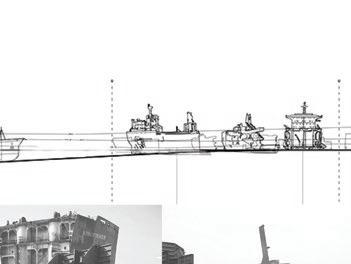
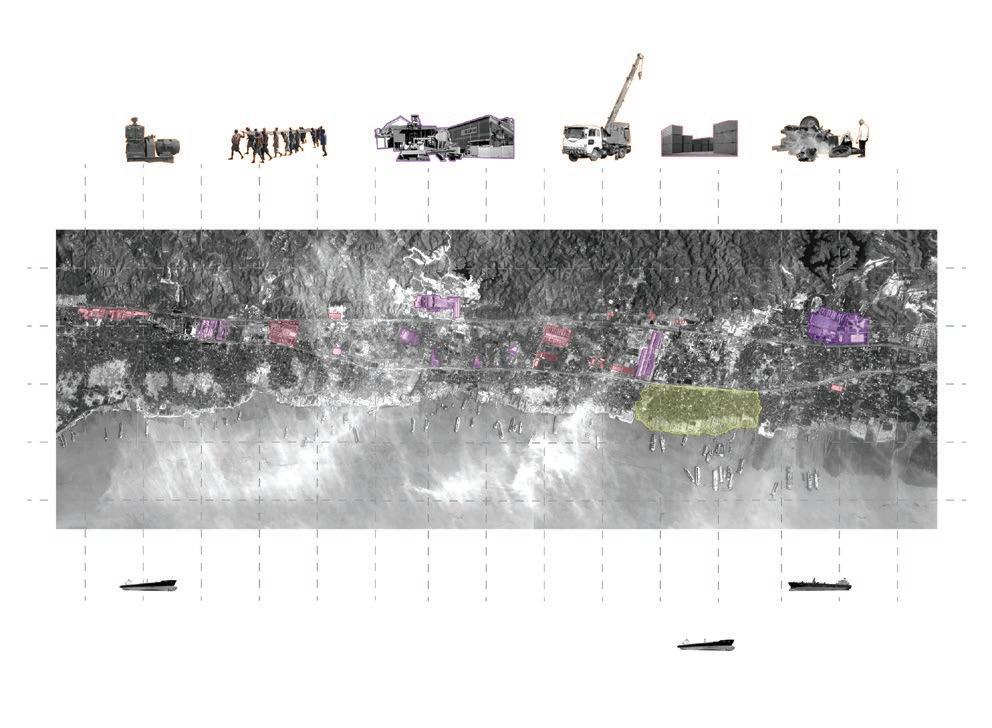
Secondary Breaking zone Sorting and Loading Unloading zone
Breaking Ship segment to smaller parts and pulling it further towards the shore
Cutting steel segments to smaller transportable parts and sent to Re rolling mills and second hand shops
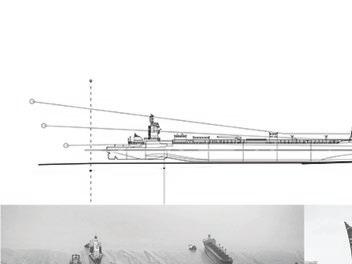
Reusable Parts
Workshop 1km 5km 10km 15km HIGHWAY RAILWAY Steel Re-rolling Mills and
Heavy Pickups for Scrap Supply Container Depot Roadside Disassembling Activity and Shops SITE P 05
Migrated Workers from North Bengal
from Ships and Roadside Machinery
other supply chain industies
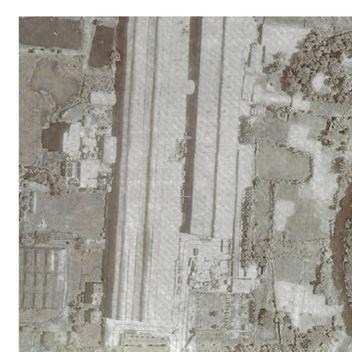
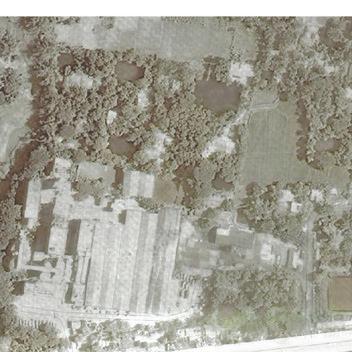

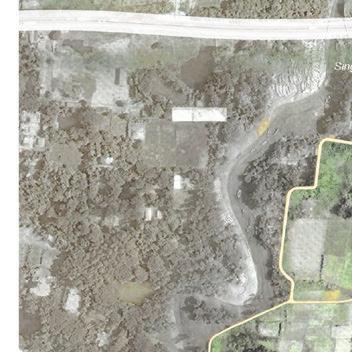
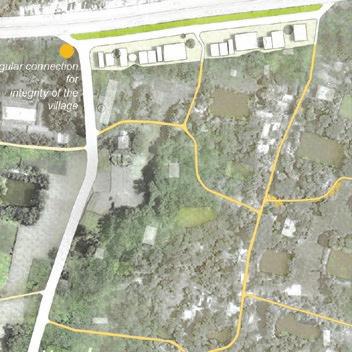
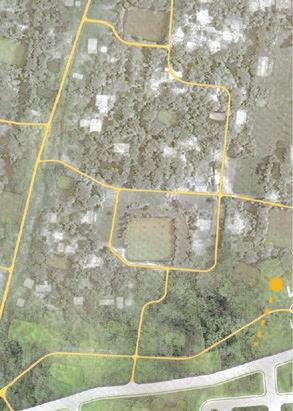
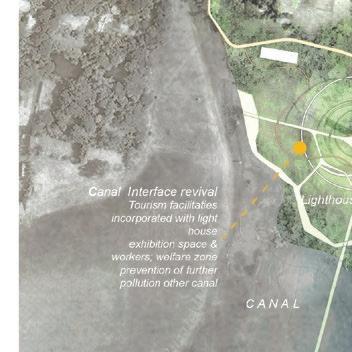
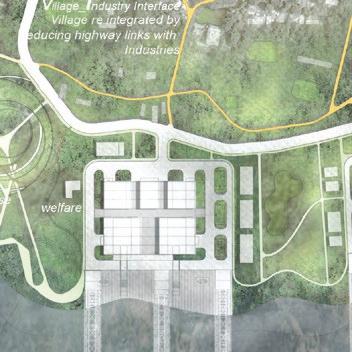
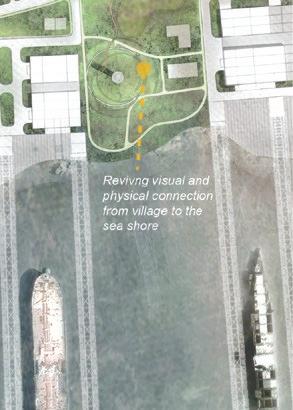
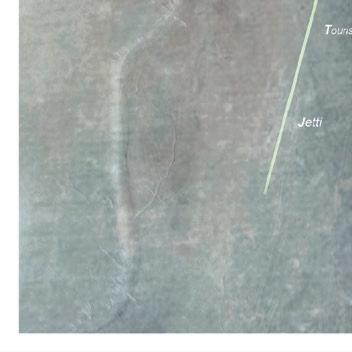
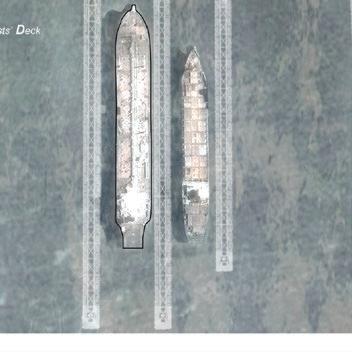
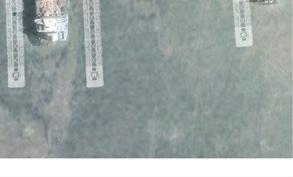
P 06
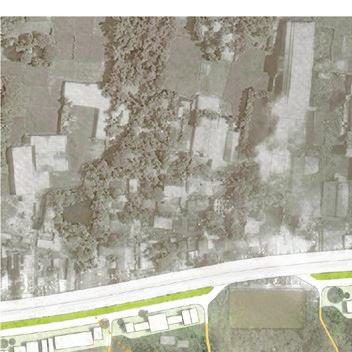
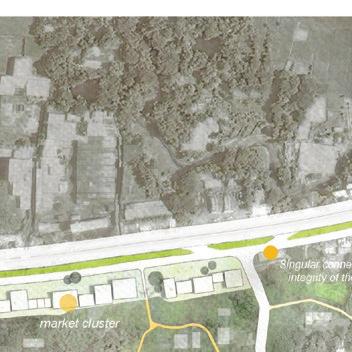

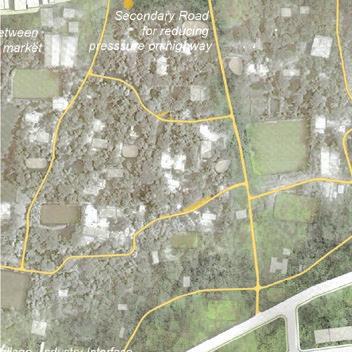
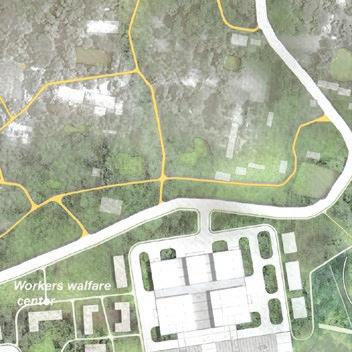
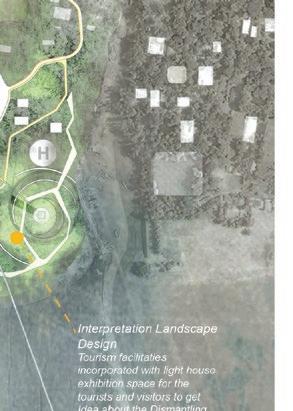
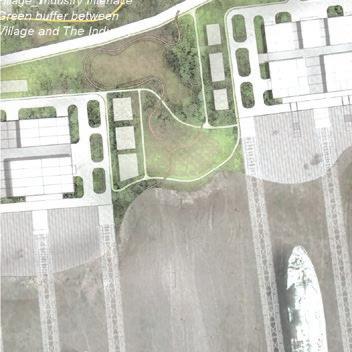
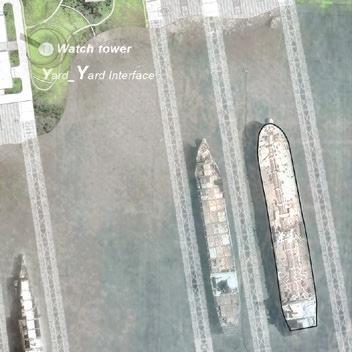
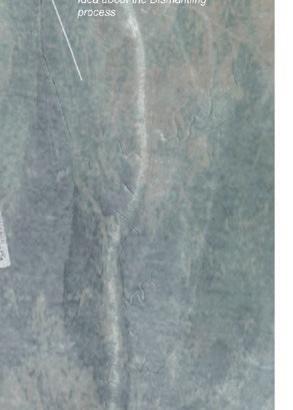
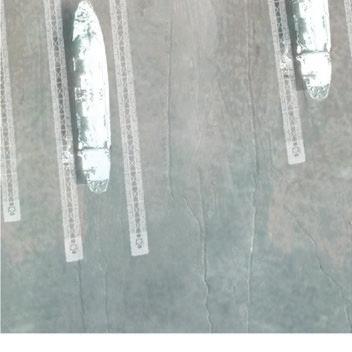
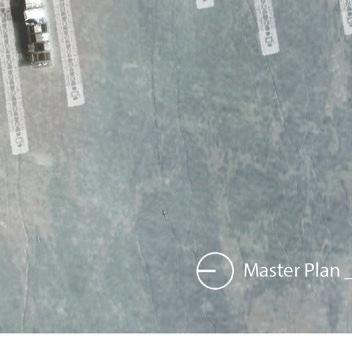
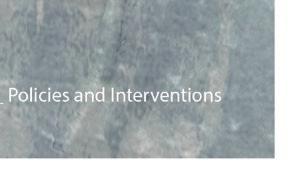





















P 07
Di
of

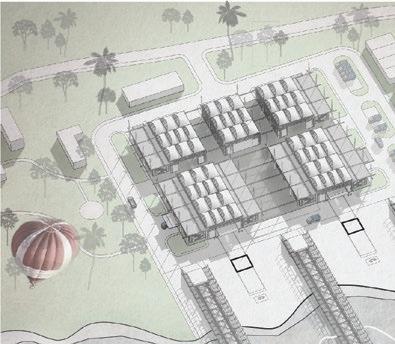
a
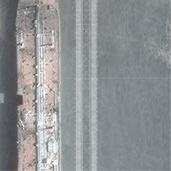
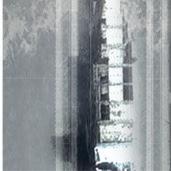
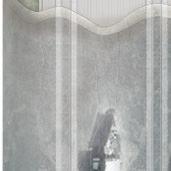
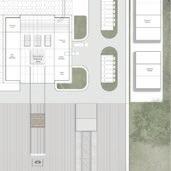
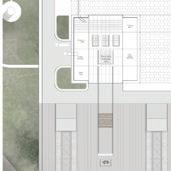
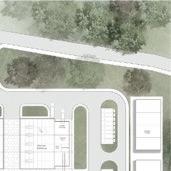
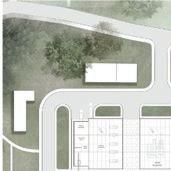

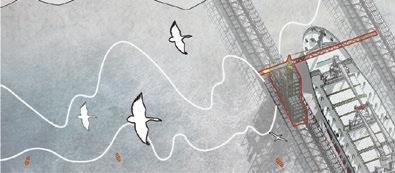
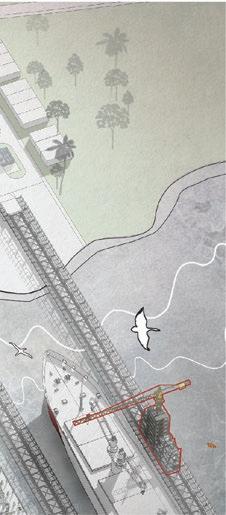
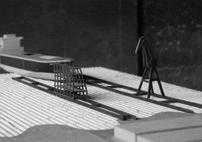
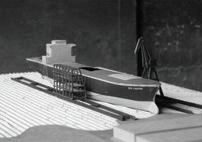
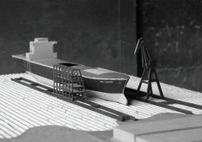


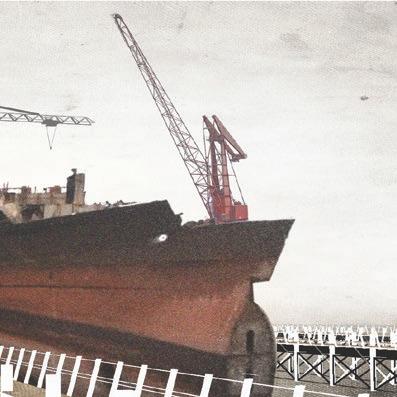
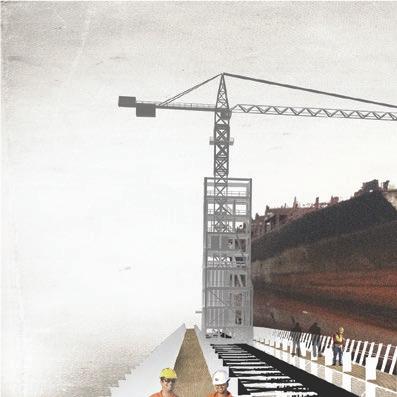 Tracks facilitating automation for transporting large segments of ship in the intertidal muddy zone (above)
erent phases
Pulling
large ship between the automation tracks by using movable Winch machine (below)
Ground oor plan of Industrial Units (below)
1) Winch Machine, 2) Secondary Breaking Zone, 3) Machine Workshop, 4) Metal Separator, 5) Loading -unloading Zone, 6) Truck Parking, 7) Temporary Storage
Tracks facilitating automation for transporting large segments of ship in the intertidal muddy zone (above)
erent phases
Pulling
large ship between the automation tracks by using movable Winch machine (below)
Ground oor plan of Industrial Units (below)
1) Winch Machine, 2) Secondary Breaking Zone, 3) Machine Workshop, 4) Metal Separator, 5) Loading -unloading Zone, 6) Truck Parking, 7) Temporary Storage
1 1 2 2 3 5 5 4 3 6 7 P 08
Axonometric View of the proposed Ship breaking yard (below)
Apparatus Design
Worker Facilities
Facilities are provided for the workers working in the interridal zone within the apparatus
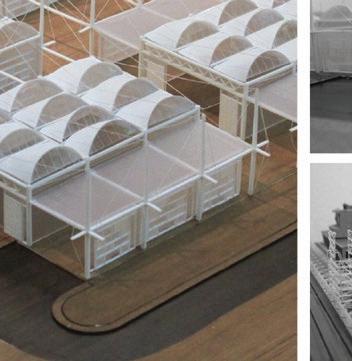
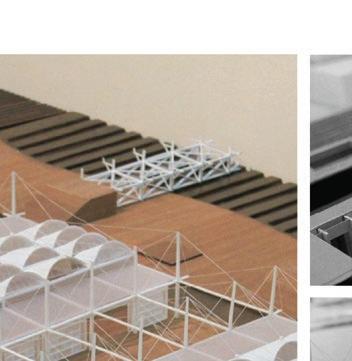

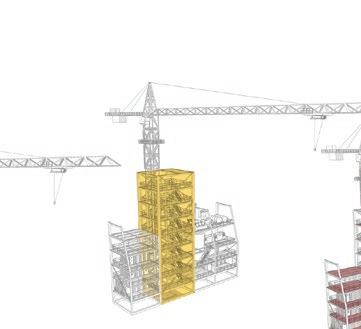
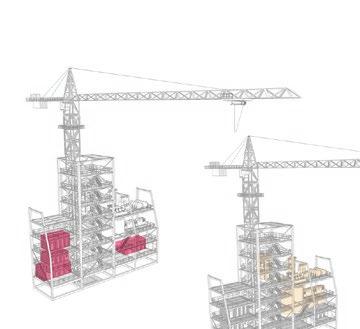
- Fast Aid facilities
- Wash rooms
- Locker rooms
Machinaries and Equipments
Mechanical Equipments and Machinaries are incorporated within the Apparatus
- Fire ghting equipments, and re pumps

- Cleaning tanks and pumps
- Generators
Virtical Circulation
Virticle access is another feature Virtical Stairs and mechanical lift for easy and safe virticle access in the ship
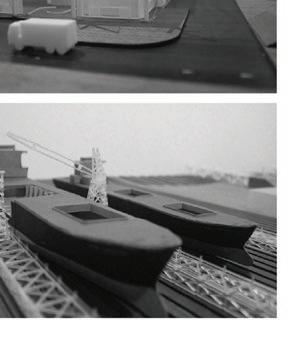
Multi-level Access
Di erent platforms for Multi-level Access and doing operational activity in the Intertidal zone
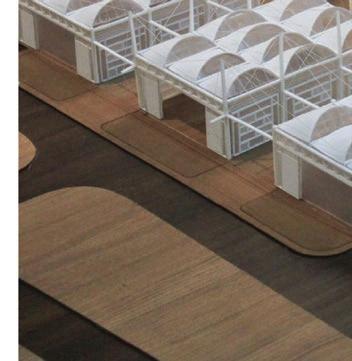
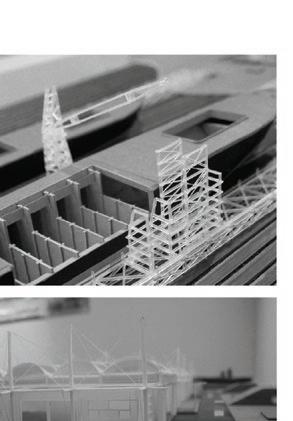
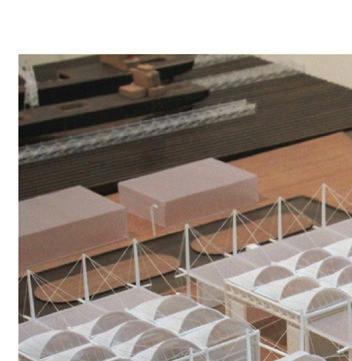
P 09
Physical model of the Project (below)
HOUSING IN MAJHIPARA : VISIONING SUSTAINABLE VILLAGE





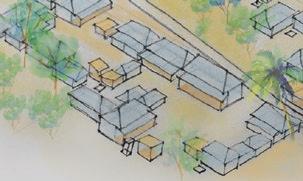

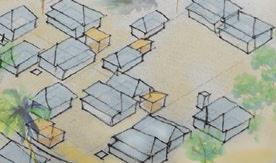
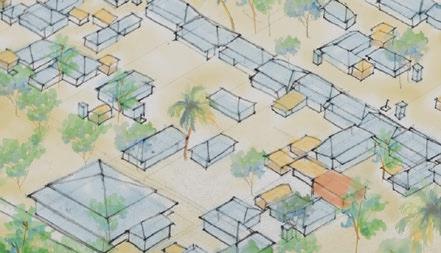

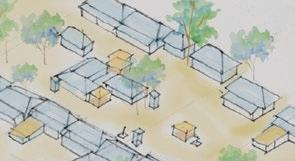
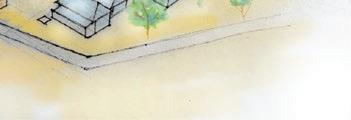




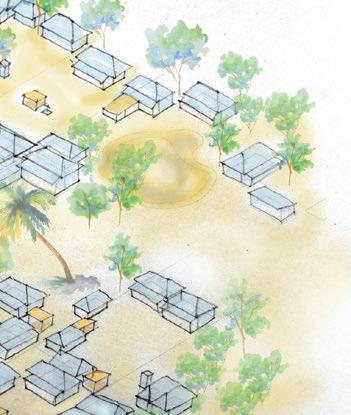

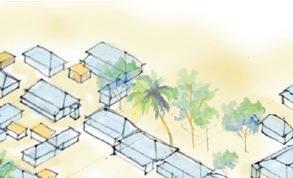

INSTRUCTOR : Dr. Shayer Ghafur, Samia Sharmin, Nusrat Jahan Mim, Labib Hossain Level - 4 ,Term 2. Design duration : Fourteen weeks April 2015
The aim of the project was to explore the Jon- Jomi-Jon in an emerging urban in Bangladesh. It was a design resesarch for visioning sustainable village for living and livelihoods by perceiving land admist population increase in Kaliakoir Upazila. The site of the project is Majhipara in Boroibari village of Kaliakoir Upazila in Gazipur district. Most of the community was sherman for many generation. Due to the industrialization of the area and pollution of the river they were forced to leave their profession of legacy and earn their livelihood as day laborer or worker in industry and others agriculture eld. The goal of the project is rethinking of living pattern of villagers by developing a compact but e ective system in the middle of usual village context. he new housing scheme accommodates the large population while conserving its traditional and cultural spaces and o ering di erent livelihood opportunities.
S Pattern of M Present ettlement ajhipara (Below)
P 10
Land ownership pattern: Land division among the neighborhood is rectilinear often distributed among brothers and cousins, formation and pattern of di erent homestead reveals the financial state concerned
Present Story

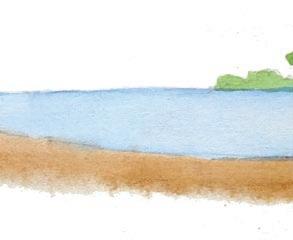
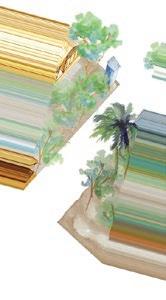
exploring the contemporary pattern & technology visible in the homestead of the communal settlement, somewhat colliding with the age old image in settlement pattern,building technology & building material
Change of the Homestead over time




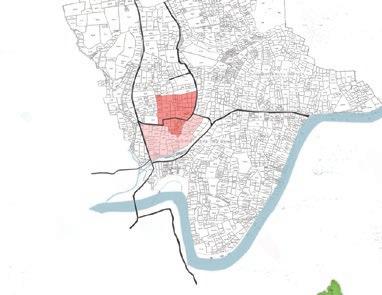


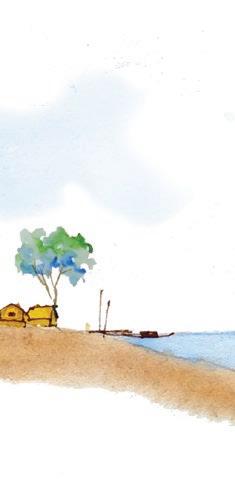
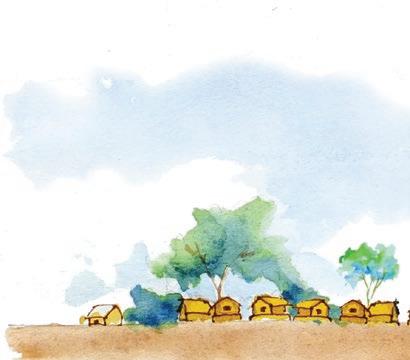
Open courtyard space is getting lost due to the increasing housing demands .(below)
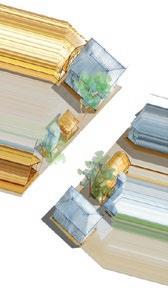
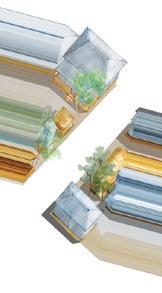
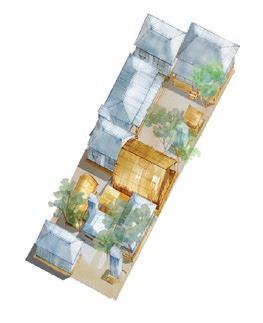
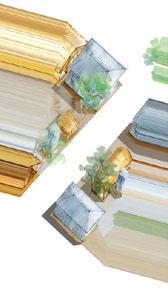
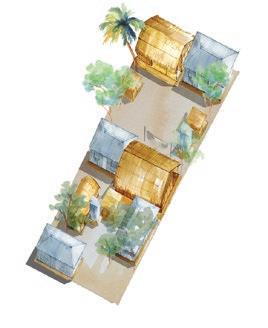

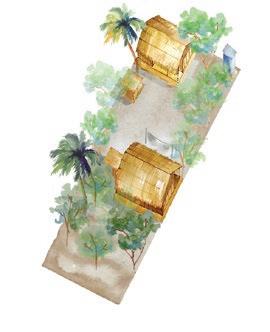
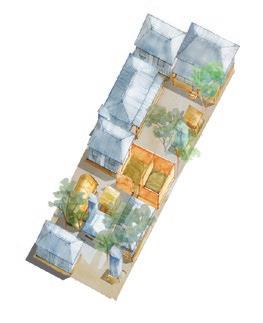
Uthan
Uthan Trees Uthan
Uthan
Uthan
extended settlement Communal Aggression 1974 1980 1985 1988 2000 2002 electricity grameen bank tubewell road first black & white tv industrial pollution 1963 1971 2003 2015 migration mobile Aggression against Hindu community Timescape : S tory of Change Mass Migration Construction of Road Industrial Pollution Grameen Bank Construction of Bridge
Trees
Trees
Trees
Trees
P 11
Housing pattern 01: income Middle & lower a ordability
income
Housing pattern 02: a ordability
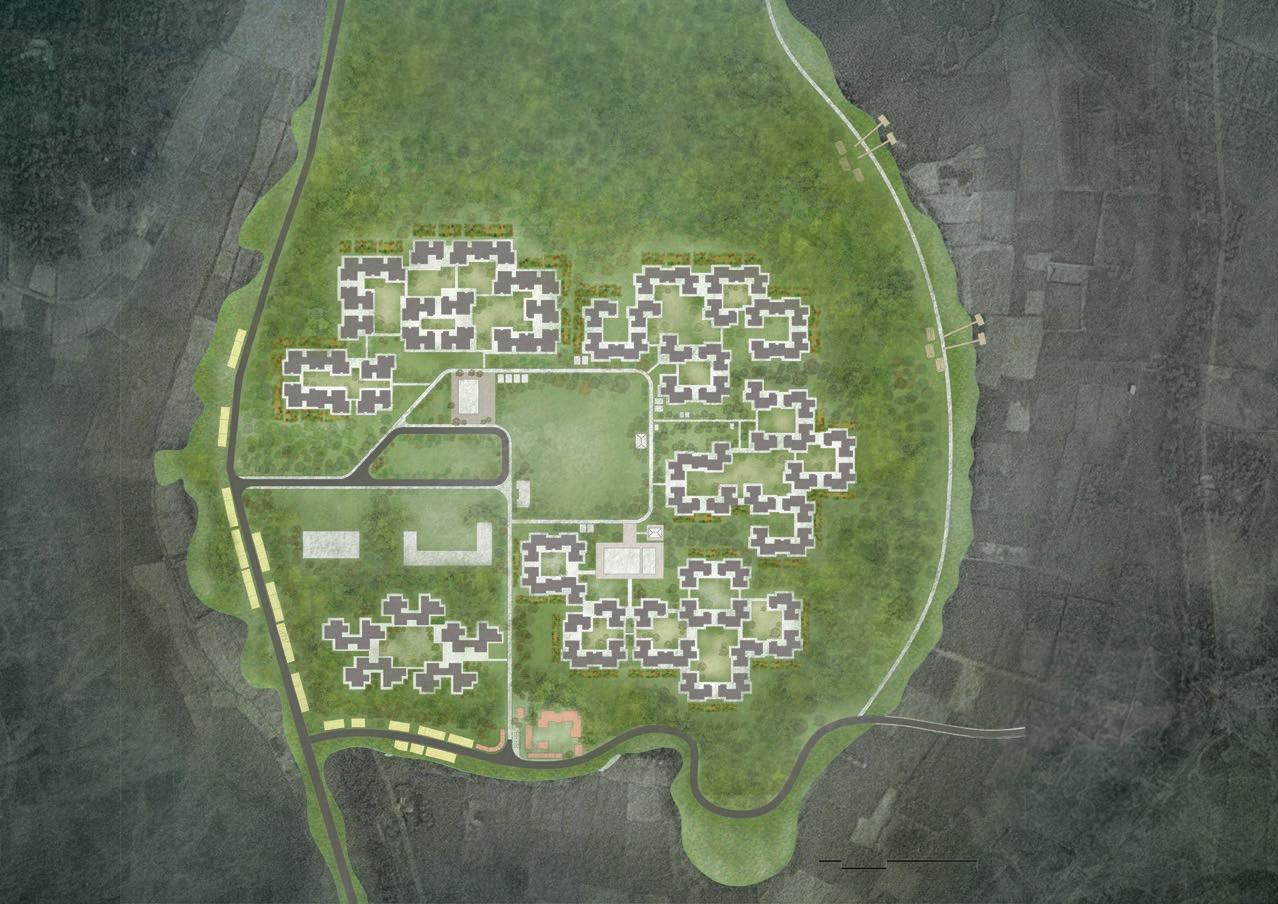
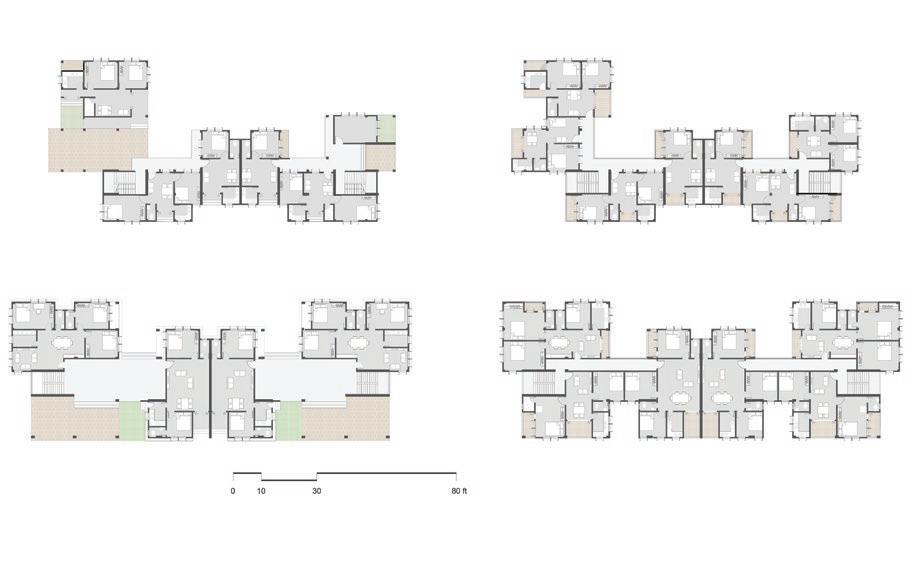
Ground Floor Plan First Floor Plan Ground Floor Plan First Floor Plan 0 50 150 450 ft 1 6 7 5 9 10 11 12 9 4 8 8 2 3
High
1) School and other facilities for the community, 2) Central Field, 3) Mosque, 4) Housing for high income community, 5) Housing for lower and middle income community, 6) Rental Housing for Industrial workers, 7) Temple, Livelihood opportunities: 8)Deck and Accomodation facilities for tourists, 9) Backyard farming 10) Rejuvenating shing bussiness, 11) Commercial, 12) Community clinic P 12
Master
Plan of Majhipara
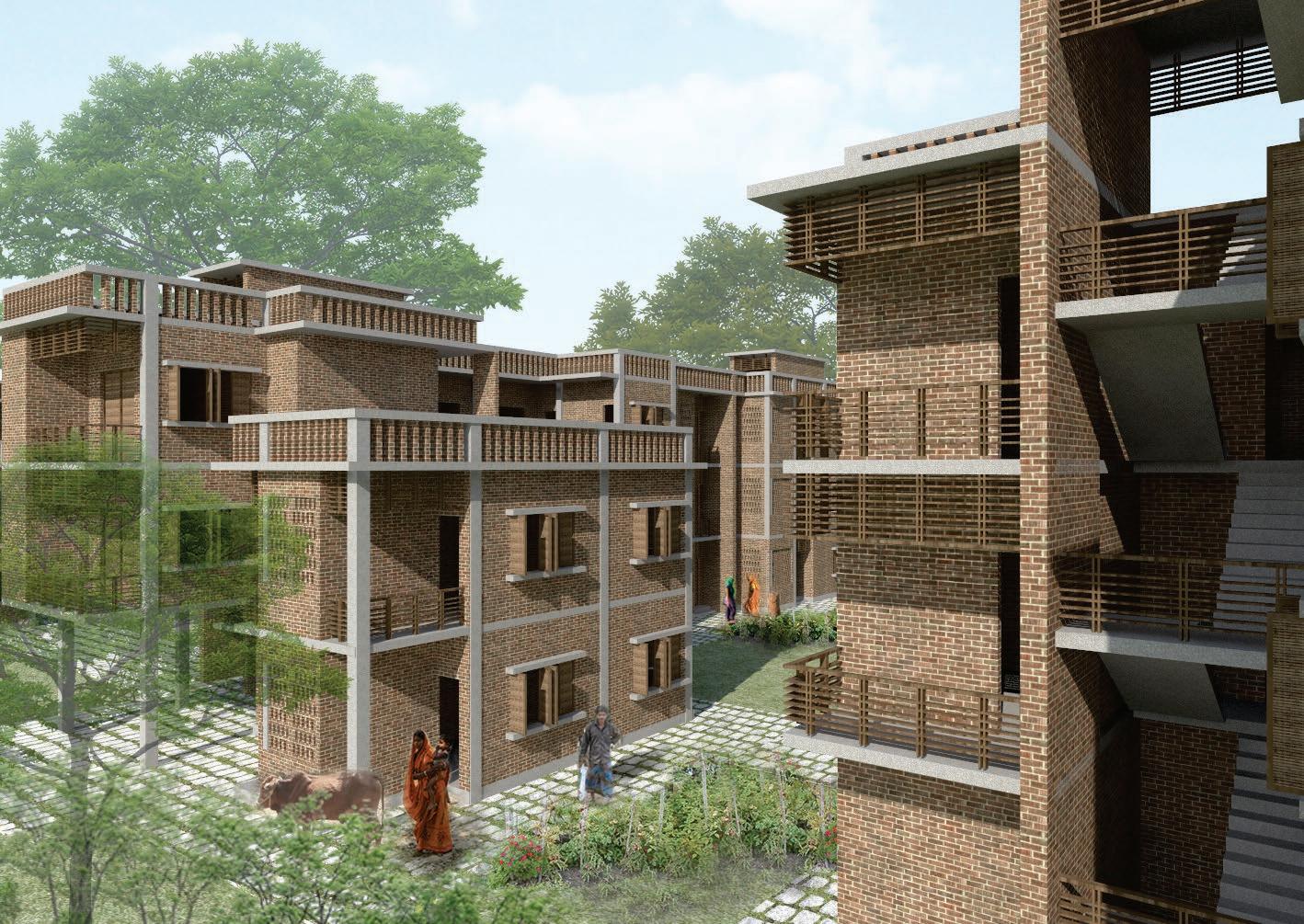

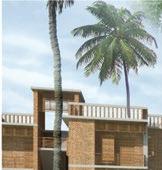
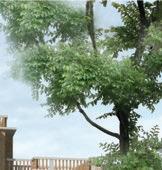
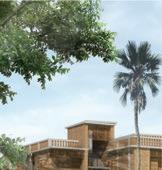
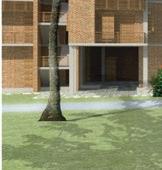
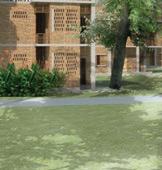

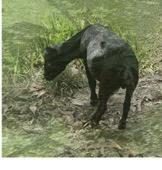
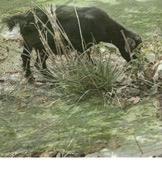

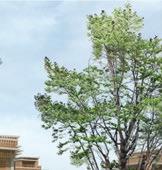
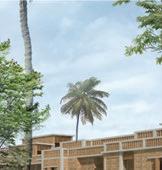
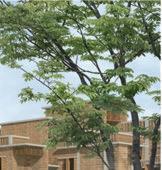
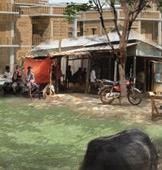
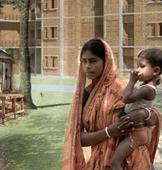
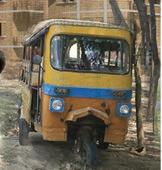
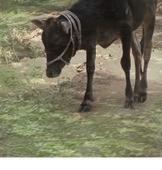
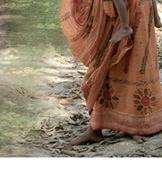
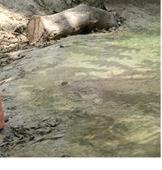
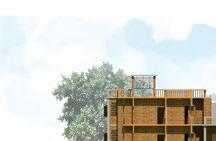
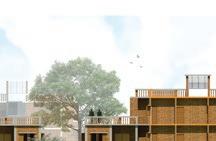

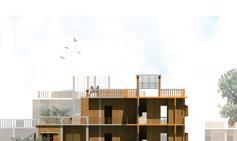
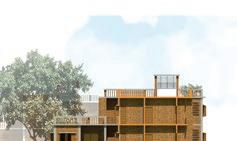 Visualisation of the Project (above)
Visualisation of the Project (above)
P 13
Section through the Courtyard (above)
REMINISENSE : THE TROPICAL SHED
KL AF 2019 TROPICAL HOUSE FOR ORANG ASLI DESIGN COMPETITION
AWARD : HONORARY MENTION CATEGORY 1: RURAL HOUSING





EXHIBITION : Kuala Lumpur Architecture Festival, KL AF 2019 organised by Persatuan Arkitek Malaysia (PAM)








TEAM: S. M. Rumman Mashrur Chowdhur y, Gautam Adhikar y, Shuvra Das , Suravi Rani Sutradhar
My contribution: Idea development and sketch, drawings, render post processing April 2019



This competition called for the design of houses for the Orang Asli of Malaysia. Orang Asli is a collec tive term widely regarded as comprising peninsular Malaysia’s original inhabitants The objec tive was to seek the best Impacting Communities, a social enterprise) to provide Basic Tropical Shelter for the Orang Asli community in Malaysia based on the two scenarios: Rural Housing, Semi-Urban Housing

Categor y 1: Rural Housing: The Clients for these designs are the rural Orang Asli who has unique communal, cultural and traditional backgrounds, including the way they build and maintain their homes.
CONSTRUC TION PHASES:
























DAY 01: DAY 02: DAY 03: EARTH EXCAVATION + PREFAB RCC FOOTING MS STRCUTURE MS STRCUTURE TIMBER RAFTERS FLOOR PURLINS ROOF PURLINS STAIR & PREFAB RAT TAN MATS TIMBER FLOORING TIMBER LOG WALLS CI SHEET ROOFING DOORS, WINDOWS, FRONT STAIR P 14
rang
Orang Asli primitive shed is the basic inspiration of idea for the proposed new home, while keeping in mind the issues of fast construction, easy assembling and making it environmentally sound, livable and contextual.
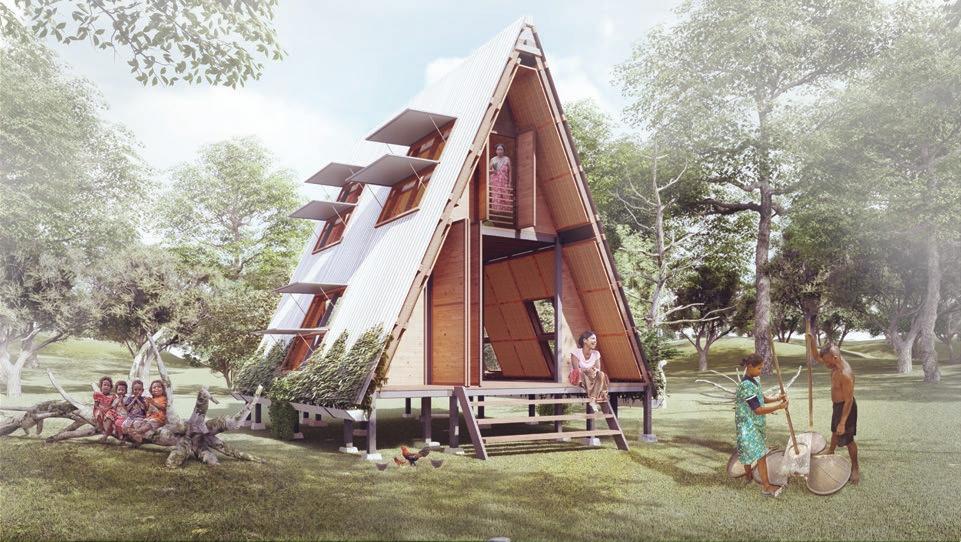
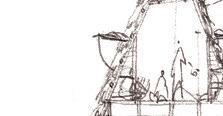
(Sketch: Shuvra Das)







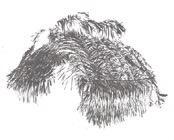
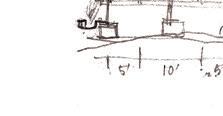


AXONOMETRIC VIEW - Components and Features
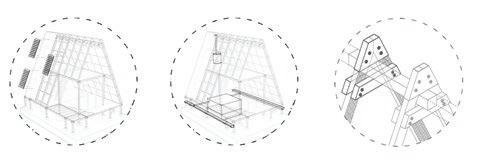
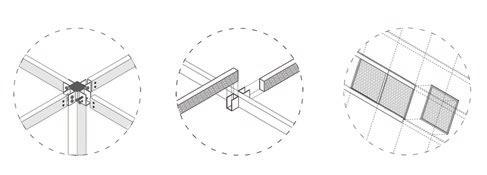


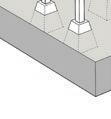

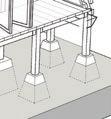
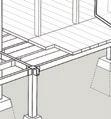
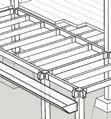
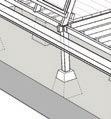
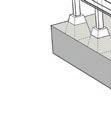

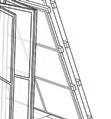
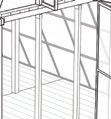
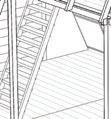
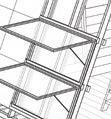
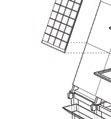
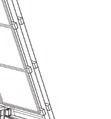
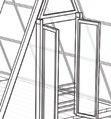
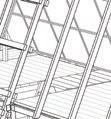
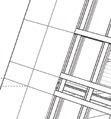

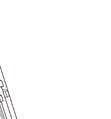
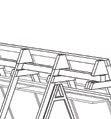
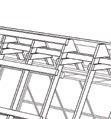

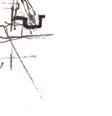 Orang Asli Tropical Shed
Orang Asli Tropical Shed
MS - MS JOINERY MS - WOOD JOINERY PREFAB RATTAN JOINERY WITH PURLIN SOLAR PANEL OVER INCLINED ROOF RAIN WATER COLLECTION SYSTEM ROOF JOINERY MS CAPPING
P 15
Visualisation of the Project (above)
HYDROPOD PLAYSCAPE: AN INTEGRATED WATER HARVESTING AND PLAYSCAPE FACILITIES
AWARD : Commendation in Berger Award for Excellence in Architecture in association with IAB, 2022
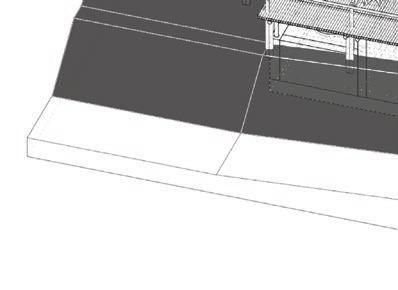

EXHIBITION : UIA World Congress of Architects 2023 in Copenhagen, in Community Architecture and Human Rights pavilion
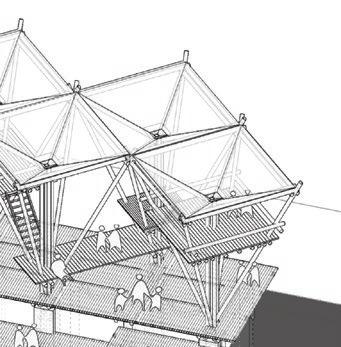
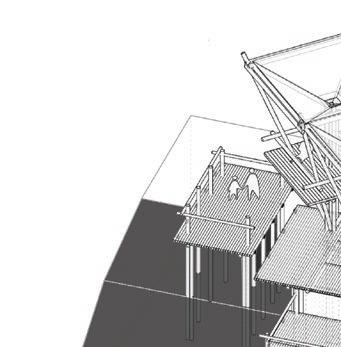
TEAM LEADER: Shuvra Das, S. M. Rumman Mashrur Chowdhury, TEAM : Gautam Adhikary, Suravi Rani Sutradhar, Ferdoush Hasann, Pintu Chakma, Suhash Ghosh. My contribution: Idea development and sketch, architectural design, construction details, workshop conduct, supervision of the construction and bamboo treatment.
Construction Completed in 2020
"Hydropod Integrated Water Harvesting and Playscape Facilities" project is in the "Megher Bari" orphanage, run by the non-pro t Bidyanondo Foundation, in a remote site of Sonaichori village of Naikhongchari Upazila, in Bandarban, Bangladesh. The chosen site faced an acute water crisis on a hill ridge when the stream water level went down in the dry season. The main design objective was to construct a large water reservoir in a sloppy terrain to reserve water for the dry season while protecting eroding soil of the site. It also accommodated rain catchers to collect rainwater in the rainy season with an integrated play space facility for the indigenous children.
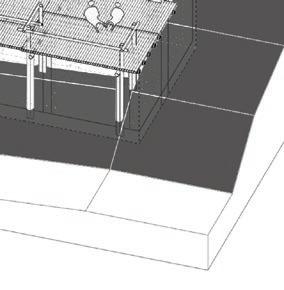
P 16 AXONOMETRIC VIEW
THE CONTEXT
The selected site, situated on the ridge of a hill, lacks proper communication infrastructure and electricity.Water was collected from the nearest stream. However, the situation gets worse in late summer and early winter when the stream water level goes down.(above)
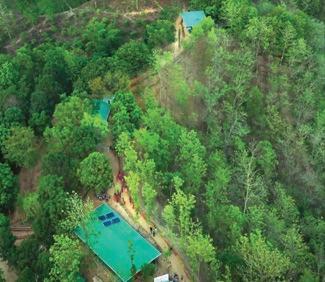
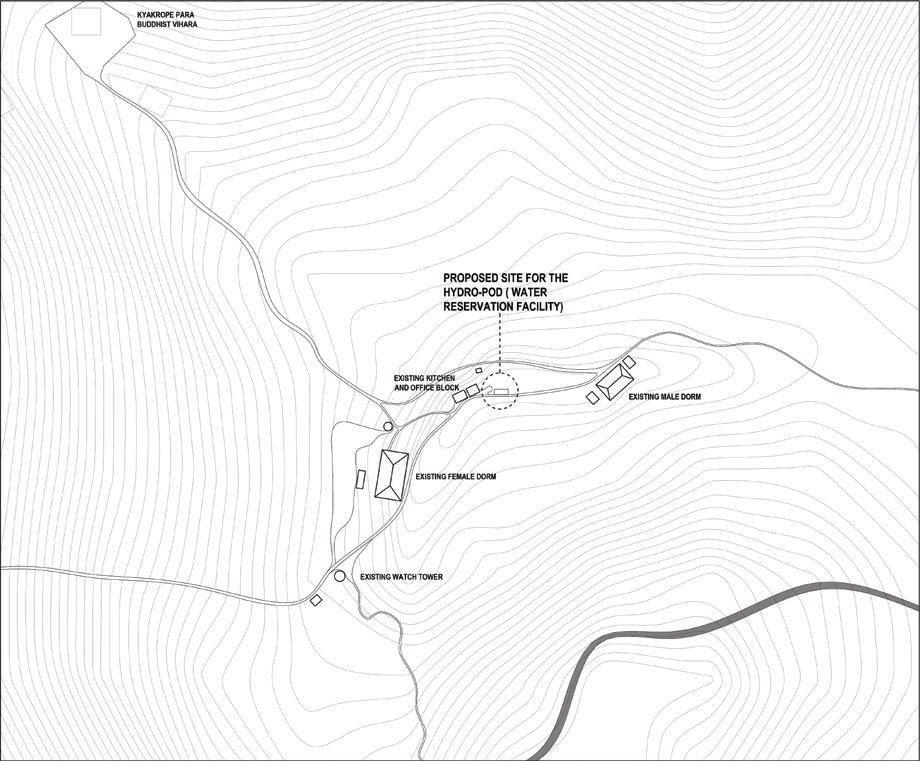
WATER STREAM AND BEHAVIORAL PATTERN
Collecting water from the natural stream is part of a daily activity for the orphanage children. In dry season, a temporary dam is made to retain water level in the downstream. (below)

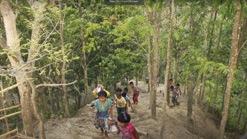
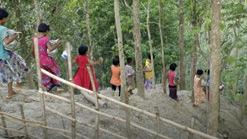 WATER STREAM
WATER STREAM
P 17
The existing Ditch (size 19’x12’x varing height) of the site with sloping edge. This unplanned inter vention by the local inchar ge caused soil
The design pr oposed a RETAIN WALL in the er oding face of the ditch with stepped BUTTRESS WALL to prevent soil er osion in the f ir st place
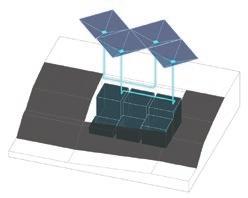
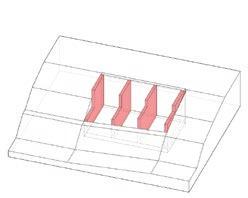
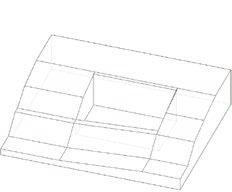
This par tition walls created six (6) CHAMBERS in between which can now be used as water reser voir with pr oper plumbing solutions.
To collect the monsoon r ain water Four (4) Rain catcher s were inst alled which can be used to dr ain water to the reser voir t ank .
The lower chamber s were connected with upper chamber with contr ol vaulve to prevent over f low of the water
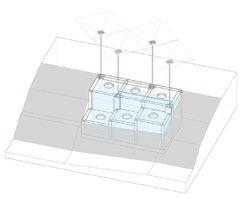
Each Raincatcher was design as an inver ted pyr amidal form to tr ansmit load in an anchore point. Each anchore point was inser ted in the met al hook placed with concrete casting of the
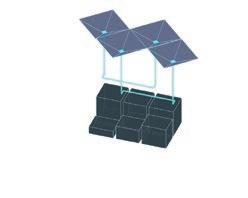
Four similar form with interconnected bamboo members created a stable three dimensional lattice work. This whole bamboo structure was capable of taking considerable live load.
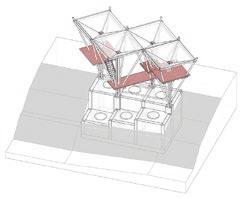
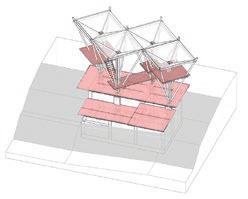
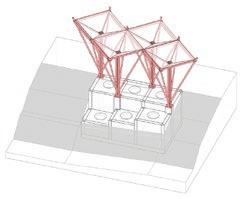
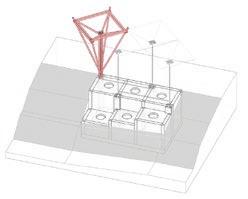
Those platforms were connected with the inclined bamboo ladder s creating a risk t aking playful movements .
In the last phase, the top sur face of the reser voir t ank was covered with deployable Bamboo mancha which can easily be removed , reshaped or replaced for easy maintenance.
DESIGN DIAGRAM
P 18
THE WORKSHOP WITH THE KIDS

Day long interactive workshop was conducted for the resident children of the Child home for mind mapping of the primary user group of the design. As the children were from di erent language cultures, a local translator actively participated in the process.(right)
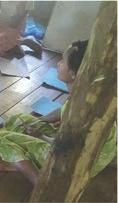
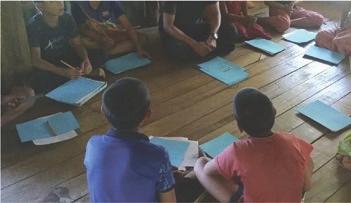
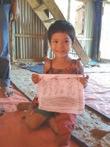

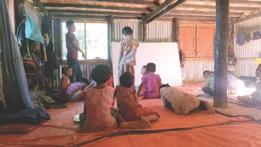
MODEL AS A TOOL OF CONSTRUCTION & FEEDBACK FROM THE ARTISANS

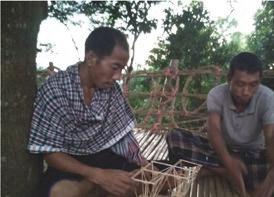

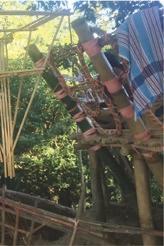

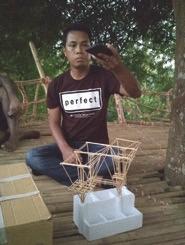
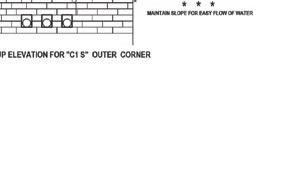

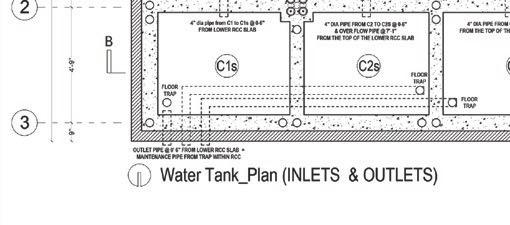
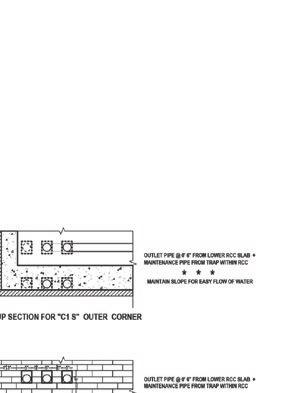
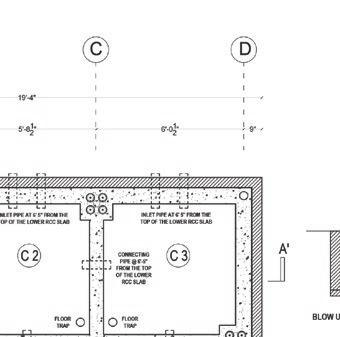
The design process acknowledged the local Marma community's prevailing "Design by Making" practice. There were some long informal Knowledge-Sharing Sessions with the Marma artisans and craftsmen of the community. The session included preliminary model-making to express and combine the extract of the shared knowledge about the technicalities and design decisions.(below)
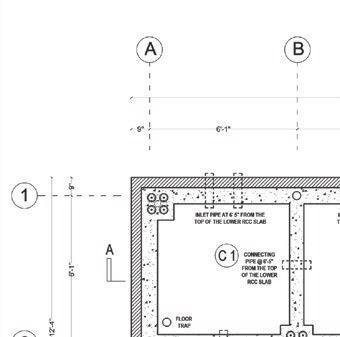
P 19
RESERVOIR AND RAIN CATCHER CONSTRUCTION

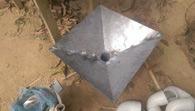

The reservoir construction involves some plumbing details to ensure connectivity between chambers and avoid over ow. The casting includes anchoring holes to hold the bamboo columns and ensure enough strength against strong wind pressure. The rain catcher was designed as a collection of four upturned pyramidal funnels supported by bamboo columns. Mostly made out of bamboo, a locally available resource, the rain catcher creates a sense of roof plane over the reservoir tank. The inner faces of the rain catchers are covered with polycarbonate sheets to ensure leakage-proof rainwater collection. In order to create lateral support, the structure includes diagonal bracings and horizontal connections, which give the superstructure a visual unity. (left)

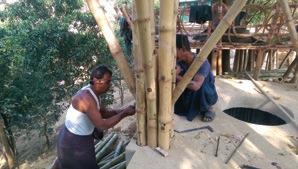
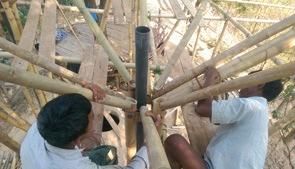
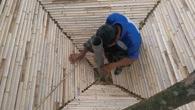
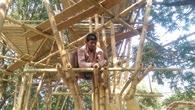
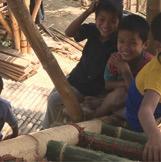
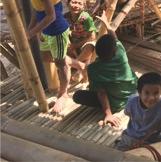
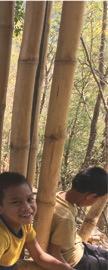
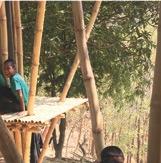
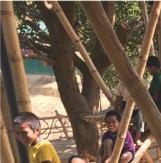

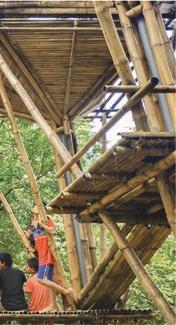
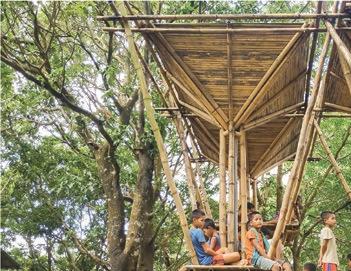
TOP VIEW 0ft 1ft 5ft 10ft SECTION AA 0ft 1ft 5ft 10ft WATER TANK WATER TANK RAIN
CONNECTING MUD ROAD
CATCHER
P 20
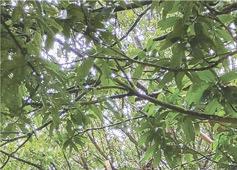
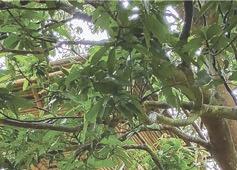
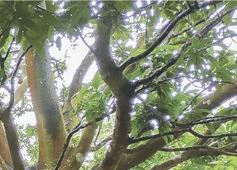

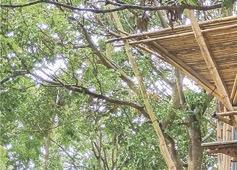
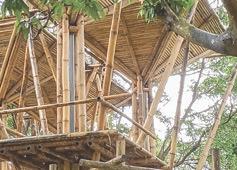
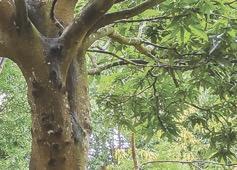
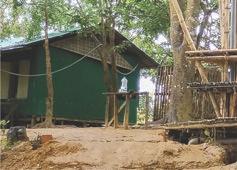
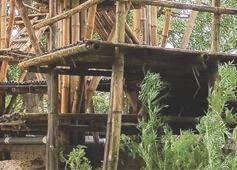
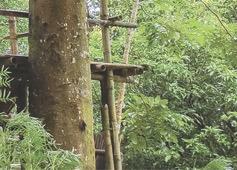

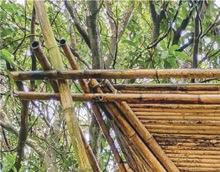

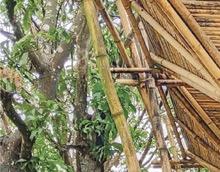
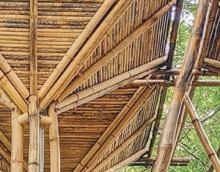
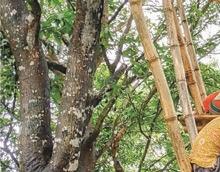
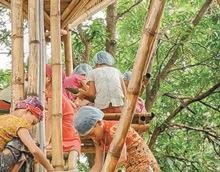
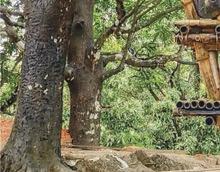
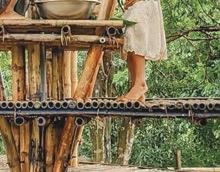

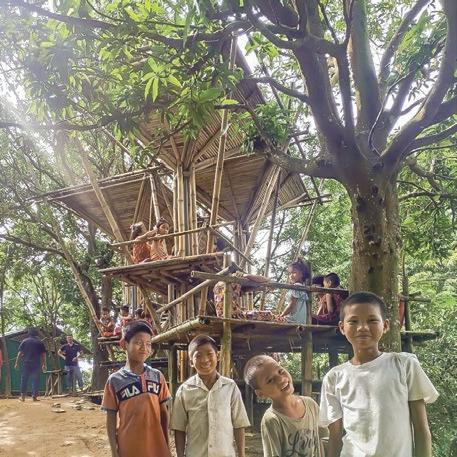
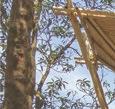
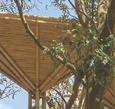

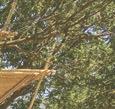
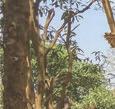
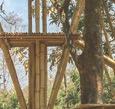
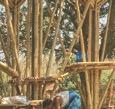
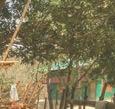


P 21
Tot al covered ground : Approx. 240 sf t , Water Storage capacity : Approximately 11000 litre
UPAZILA COMMUNITY PARK: RECLAIMING AN ABUNDANT LAND THROUGH PLACEMAKING
DESIGNED FOR : ANOWARA UPAZILA PARISHAD
TEAM LEADER: Shuvra Das, TEAM :Suravi Rani Sutradhar, S. M. Rumman Mashrur Chowdhury, Kamrul Hasan MY CONTRIBUTION: Idea development and sketch, landscape design, visualizations, supervision of the construction and plantation.
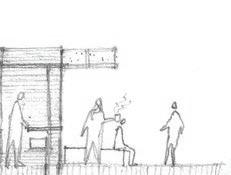
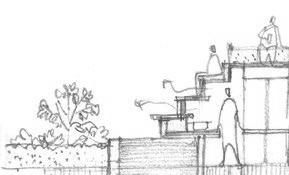
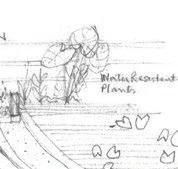
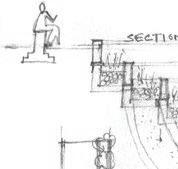
Construction Completed in 2022
An abundant half-acre of land beside a government o ce in Anowara Upazila (Subdistrict) was assigned for this community park development project. The objective was to reclaim the land from being a wasteland and protect it from local land grabbers. The intention was to generate a self-maintaining ecosystem that replenishes the soil and promotes local plant species and biodiversity. As most of the existing large-scale trees were beyond the boundary wall, a collection of local plants was sourced from the local nursery and planted after subsequent preparation of the soil bed. A diverse local species of trees, shrubs, and shrubs were selected to foster local biodiversity – ora and fauna.
The soil was recon gured through a local “DIG AND MOUND” process to create a landscape terrain with a range of 1 to 1.5 meters below and above the ground. It helped to create a diverse landscape experience for the local visitors within the half-acre site while o ering a sense of con nement and revealment. A central pond as a rain garden was created to hold the surface runo water during the monsoon while ensuring moisture for the soil condition.
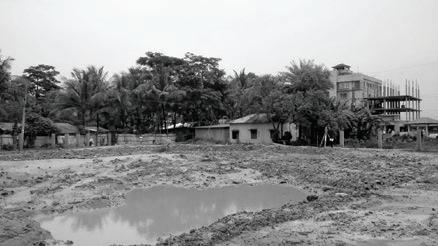
INITIAL IDEAS


THE CONTEXT
The site is surrounded by local administrative o ces and residential blocks, Previous site condition, land partially lled with sand (below)

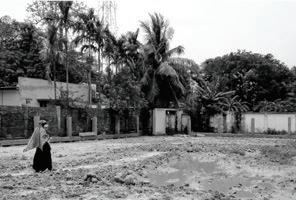
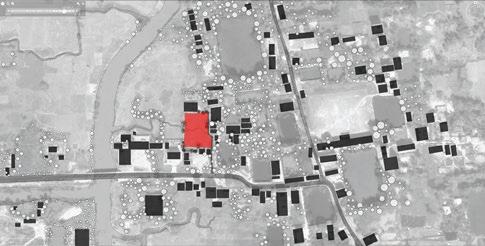
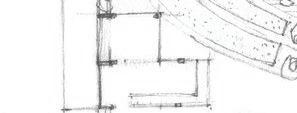 The semi-open café intentionally hides a part of the landscape visually to welcome visitors to explore and walk the pathway. Also, an open stairway invites the user to sit on the roof. (Sketch: Shuvra Das)
The semi-open café intentionally hides a part of the landscape visually to welcome visitors to explore and walk the pathway. Also, an open stairway invites the user to sit on the roof. (Sketch: Shuvra Das)
P 22
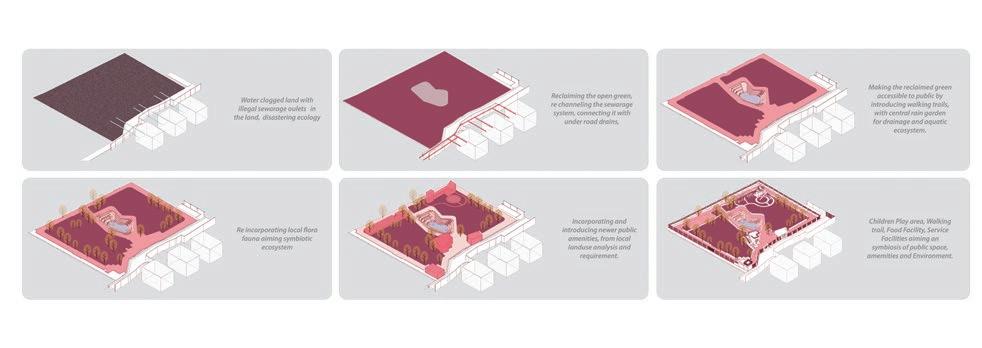

MASTERPLAN
P 23
The Site has a direct access from the adjacent Government o ce (Land o ce) on the south side and from the Secondary Road on the east side (above)
SOFT PAVE
A soft pavement made of wastage brick parts serves as a running track for the local children while ensuring rainwater penetration.
OPEN STAGE
Locals can organize community programs and events on the open stage, and people can congregate in front of the stage on the sloping green grass.
PUBLIC WASHROOM
A public washroom is provided with in the park premises ensuring easy access of public sanitation and drink water for the daily users.
WATER BODY
To capture surface runo water during the monsoon and maintain moisture for the soil, a central waterbody serving as a rain garden was built.It supports aquatic plants, and serves as a water supply for other non-human life throughout the summer.
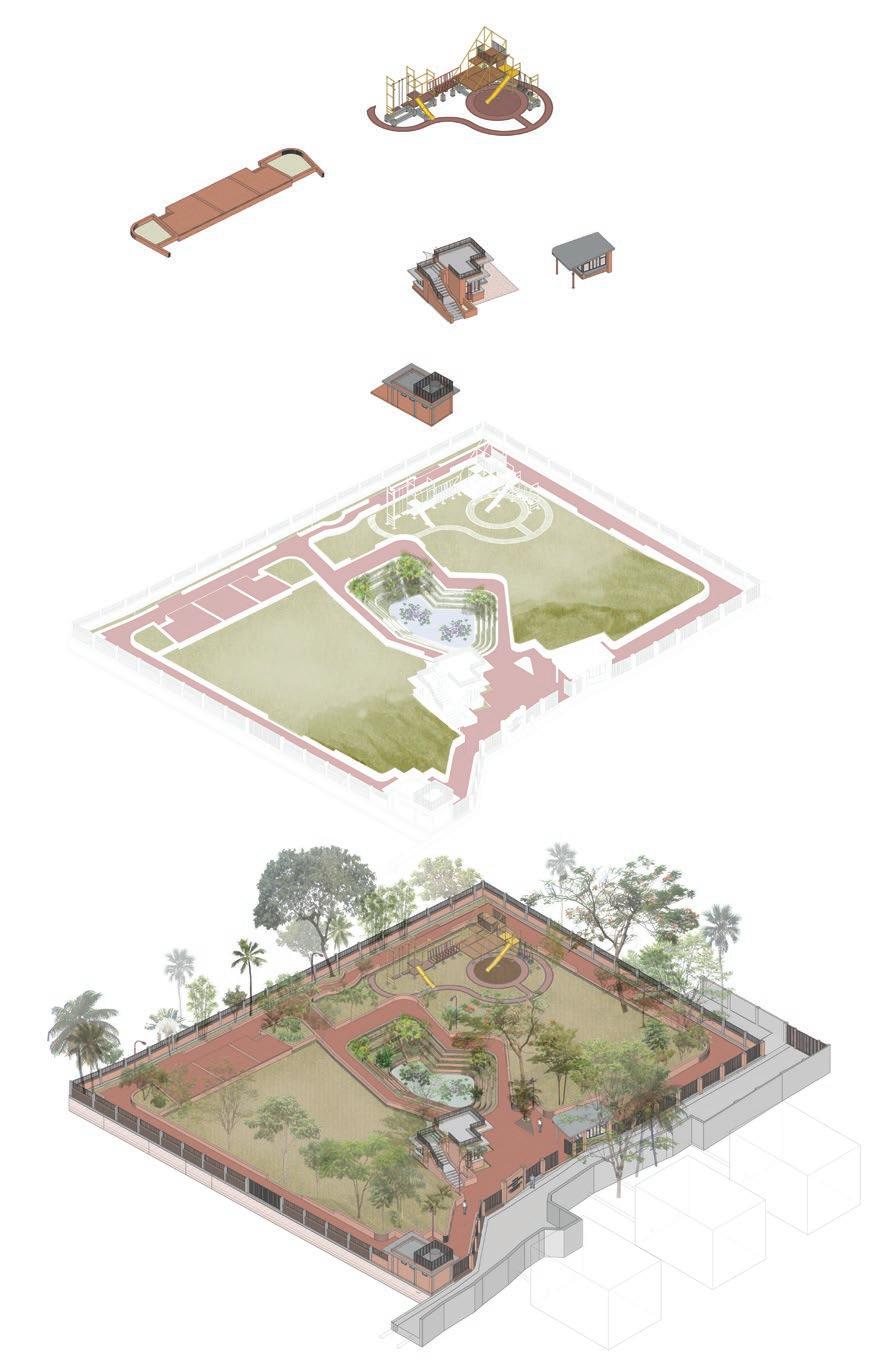
CHILDREN PLAY ZONE
A Children's playscape is installed in the north-western corner of the park that involves physical movement and challenges for the growing children of the community. Incorporating Multiple platforms in di erent levels and inducing various game activities within the composite structure brings together various age groups of children.
GUARD ROOM
The guard room provides a room for the caretaker of the park, who also looks after the security issues.
SEMI OPEN CAFE’/ REFRESHMENT
At the entry, a semi-open café welcomes guests to have snacks, and a staircase calls out users to walk up and sit on the small café's rooftop for an unobstructed view over the entire park. .
MOUNTED SOIL
Mounted soil to create a landscape terrain with a range of 1 to 1.5 meters above the ground, o ering a sense of con nement and revealment.
THE PAVEMENT
The shapes and con gurations of the pathways encourage people to stroll in a continuous loops, altering their views. The constant half walls enable the elderly to pause for a little while and sit there at any time.
MAIN ROAD
Surrounded by government administrative o ces and local residential blocks, the site had an easy access from the adjacent land o ce as well as the main Road.
-
2 1 3
EXPLODED AXONOMETRIC VIEW
Interventions and Features
ENTRY GATE 4 5 6 7 8 10 9 P 24
SECTION THROUGH THE WATER BODY

The pond nurtures the aquatic plants fostering biodiversity of the site (above)
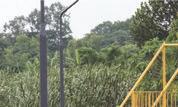
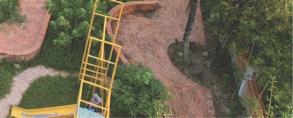

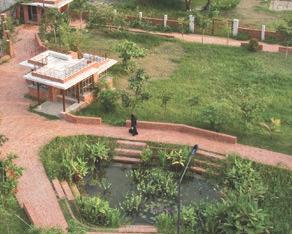
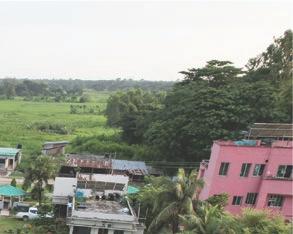
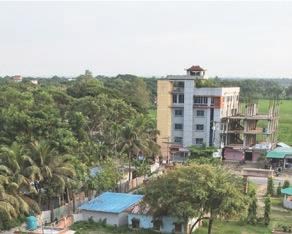
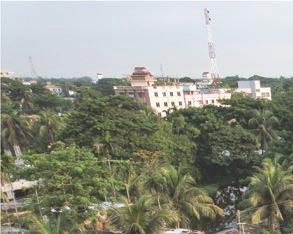
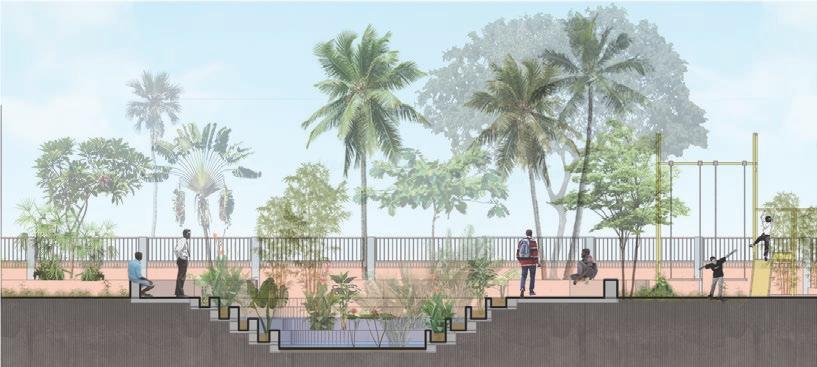
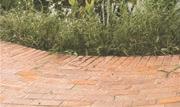
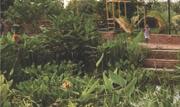
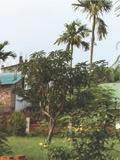
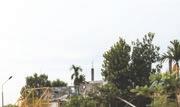
The park invites the children to explore the park in their own way rather than creating a de ned experiential journey. (below)
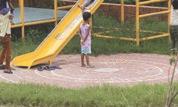
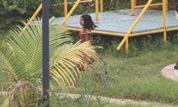
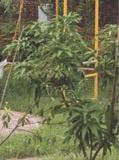
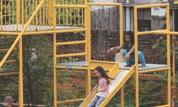
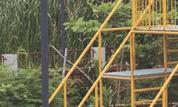
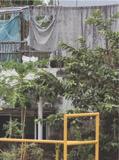
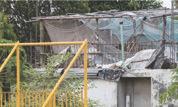

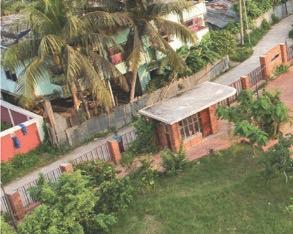
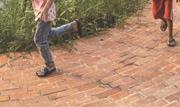
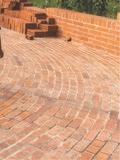
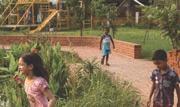
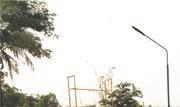
P 25
THANK YOU


























































































 Tracks facilitating automation for transporting large segments of ship in the intertidal muddy zone (above)
erent phases
Pulling
large ship between the automation tracks by using movable Winch machine (below)
Ground oor plan of Industrial Units (below)
1) Winch Machine, 2) Secondary Breaking Zone, 3) Machine Workshop, 4) Metal Separator, 5) Loading -unloading Zone, 6) Truck Parking, 7) Temporary Storage
Tracks facilitating automation for transporting large segments of ship in the intertidal muddy zone (above)
erent phases
Pulling
large ship between the automation tracks by using movable Winch machine (below)
Ground oor plan of Industrial Units (below)
1) Winch Machine, 2) Secondary Breaking Zone, 3) Machine Workshop, 4) Metal Separator, 5) Loading -unloading Zone, 6) Truck Parking, 7) Temporary Storage



































































 Visualisation of the Project (above)
Visualisation of the Project (above)








































































 Orang Asli Tropical Shed
Orang Asli Tropical Shed









 WATER STREAM
WATER STREAM




















































































 The semi-open café intentionally hides a part of the landscape visually to welcome visitors to explore and walk the pathway. Also, an open stairway invites the user to sit on the roof. (Sketch: Shuvra Das)
The semi-open café intentionally hides a part of the landscape visually to welcome visitors to explore and walk the pathway. Also, an open stairway invites the user to sit on the roof. (Sketch: Shuvra Das)




























